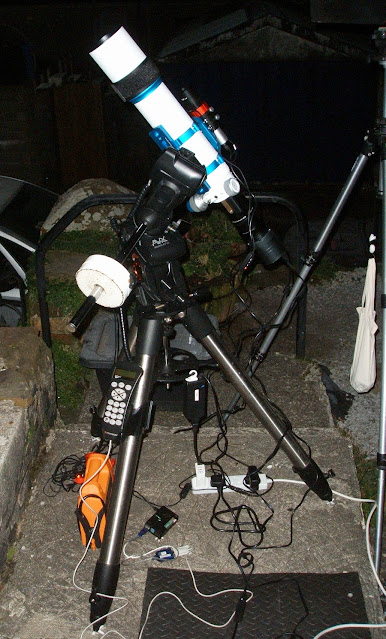A William Optics f/6.9 Zenithstar 81 ED APO doublet refractor, f/5.5 with 0.88 APO flattener-reducer, AstroDMx Capture and an SV605CC OSC camera; first light. The APO telescope has a Synthetic flourite ED doublet element.
This scope has a unique front dust cap
Unscrewing the end of the dust cap reveals the patented built-in Bahtinov mask
A handle attached to the scope rings has a standard dovetail to which a guidescope can be mounted in a fairly well balanced position.
The equipment used
The scope was placed on permanent marks on the concrete base.
A UV/IR cut filter was placed in the optical train via an Altair magnetic filter holder.
The hand controller was connected to the Raspberry Pi running an INDI server and communicated with the indoor computer running AstroDMx Capture via WiFi. An anti-dew heater strip was placed around the objective cell of the scope. An SVBONY SV165 guide-scope fitted with a QHY-5II-M guide camera was mounted on the handle dovetail of the imaging scope.
AstroDMx Capture passed the time, altitude and location coordinates to the hand controller via the INDI server. The hand controller which now contained all of the correct information was set to its previous alignment and was unparked by AstroDMx Capture.
AstroDMx Capture connected the SV605CC OSC camera natively by USB, and sent the scope/mount to Vega.
The patented William Optics Bahtinov mask was used to bring Vega to focus.
A guide computer running an INDI server was used for multi-star PHD2 pulse auto-guiding and the guide camera was connected by USB.
AstroDMx Capture was then used to send the mount/scope to M31, plate solve the field of view, and centre the object.
AstroDMx Capture was used to capture 70 x 1 min FITS exposures of the Andromeda galaxy
The 70 images were stacked and partly processed in Deep Sky Stacker and post processed in The Gimp 2.10 and Neat Image.
The Andromeda galaxies, M31, M31 and M110
The William Optics f/6.9 Zenithstar 81 ED APO doublet refractor, f/5.5 with 0.88 APO flattener-reducer performed very well showing extremely good colour correction and good stars.
I had been struggling for several months with a Skywatcher Esprit 80 ED Triplet APO refractor in which the stars flared badly, ruining the results. Rother Valley Optics were very helpful and organised a return of the scope and the issuing of a new Zygo tested William Optics Zenithstar 81 ED APO doublet at my request plus a 0.88 William Optics APO flattener-reducer. I was very happy with their cooperation and felt that it should be mentioned here with the first light results of the new scope.
I shall be able to tweak the spacing with the adjustable 0.88 flattener-reducer until I have the field as flat as it can be.







